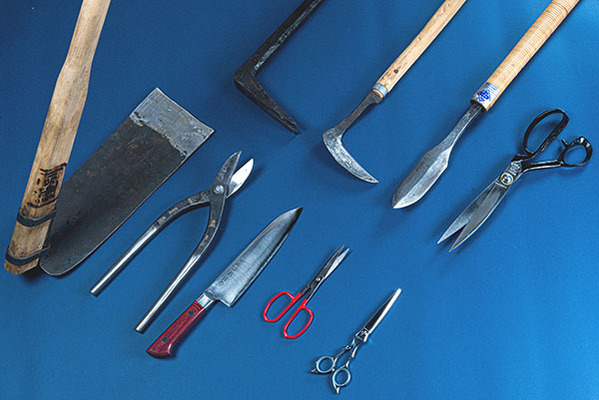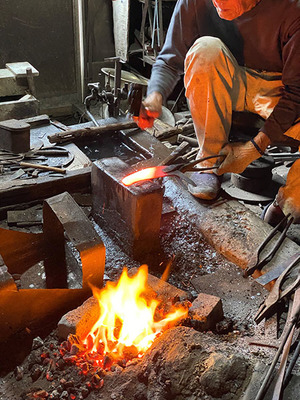
- Metal works
- Chiba
Chiba Artisan Tools Chiba Koshogu
Various tools where the delicate craftsmanship of blacksmiths can be seen
A traditional craft created in a productive land
Description
What is Chiba Artisan Tools ?
Chiba Artisan Tools are cutlery and hand tools made in the Boso Peninsula of Chiba prefecture, using traditional techniques. Their main products are sickles, hoes, knives and western style scissors.
As iron sand was mined in the Boso Peninsula from a long time ago, there have been many blacksmiths in this area. They make a wide variety of tools, but they are especially known all over the country for producing artisan tools which are used by artisans and craftsmen.
Scissors are made using an original technique called ha awase (combining blades using a hammer or file), and other products are made using tataki zokei (shaping with a hammer or chisel) or katagiri zokei techniques. The straightening, sharpening, and finishing processes are all done by hand. High quality tools are produced by the skilled craftsmen.
History
As the Boso Peninsula is a production area of iron sand, iron manufacturing and forging has flourished in this area since ancient times. After Ieyasu TOKUGAWA started the Edo Shogunate, large contructions such as river conservation work at the Tonegawa river and reclamation works at Inbanuma were carried out. This lead to increase the number of blacksmiths that made artisan tools for carpenters and farmers. At the end of the Edo period, the area became famous as a production area for artisan tools.
Boso Peninsula is also know as the place where dairy farming in Japan started, and there were many farms all around this area. This also lead to the development of Chiba Artisan Tools. In the Meiji Era, demand for pastoral farming increased, and production of western scissors, knives, sickles and other tools also increased. After the Dampatsurei where the government ordered men to cut their top-knots, demand for hairdressing increased, which led to the increase of hairdressing scissors' production.
Today, craftsmen using the traditional techniques and methods continue to produce artisan tools. The tools being handmade with traditional high skills adds charm and beauty to this craft.
Production Process

- 1. Selecting the material
Iron or steel is selected depending on the type of product being made (scissors, sickles, knives etc.) or the purpose of use. Sometimes a hammer is used to beat the iron or steel to check its hardness and flexibility.
- 2. Making the base iron
The selected iron is placed in the forge to be heated. The heated iron is then placed on an anvil and is beaten with a hammer to the appropriate size and thickness.
- 3. Beating and shaping
(Process for producing sickles and scissors)
The iron heated in the forge is placed on the anvil to be beaten with a hammer and shaped to the designated shape. For making scissors, the iron is beaten to a long and narrow shape. The jointing parts and finger rings are also shaped at this stage.
- 4. Cutting the shape
(First process for producing western style knives)
A pattern paper is placed on the iron or steel that has been forged. The pattern lines are traced, and the iron or steel is cut using a press cutting tool or with a hammer and chisel.
- 5. Forge welding
Steel is heated in the forge and is beaten to a long and narrow flat plate with a machine or hand hammer. The plate is then cut to the designated length with a chisel.
A forge welding agent made from boric acid and iron powder is applied to the heated base iron while it is burning hot. The iron base is then covered with the steel prepared beforehand, is further heated, and is beaten with a machine or hand hammer.
- 6. Quenching The material is heated in the forge at approximately 850 degrees Celsius. When it becomes by and large red, it is quenched to harden the steel. The way of quenching (water cooling or oil cooling) differs depending on the degree of hardness of the finished product.
- 7. Tempering
The quenched material is heated in the forge to approximately 200 degrees Celsius. When it is thoroughly heated, it is cooled in water or oil again. This gives flexibility and toughness to the steel.
- 8. Straightening and shaping
Any deformations produced in the quenching and tempering processes are adjusted with chisels, hammers and straightening tools.
- 9. Whetting
The part to become the blade is whetted with pig iron, whetstone or on a grinding wheel. In order not to heat the material again by friction, the material is soaked in water and whetted, and this process is repeated. A coarse whetstone is used in the beginning and is changed to a finer whetstone as the whetting proceeds.
- 10. Combining the blades
(Process for producing products that have two blades such as scissors)
The blades are combined by hammering the joint parts in different ways depending on the purpose of use such as for pruning, sewing, and haircutting. The angle of the edge is adjusted with a file or whetstone.
- 11. Finishing
The handle appropriate for each product and shape of the blade is attached. The final whetting and sharpening is processed and the product is complete.
Other Metal works
- Nambu ironware
- Takaoka copperware
- Yamagata cast iron
- Sakai cutlery
- Tokyo silverware
- Echizen cutlery
- Osaka naniwa pewterware
- Tosa cutlery
- Tsubame-tsuiki copperware
- Shinshu Forged Blades
- Banshu-miki cutlery
- Higo inlays
- Echigo-sanjo cutlery
- Echigo-yoita cutlery
- Chiba Artisan Tools
- Tokyo antimony craft































































































































































































































































































